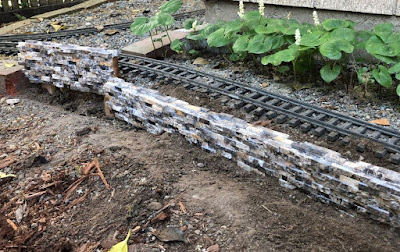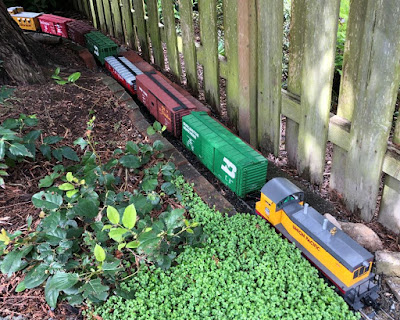As this was a three-day weekend I had a little extra time so I started work on a long overdue project, building a wooden trestle for an elevated section of track that has, for the over three years, been sitting on top of PVC pipes.
Here is a link to my blog post from August, 2016 when I first put this in and it has held up incredibly well with almost no settling and very little maintenance. It may look ridiculous, but the PVC solution was amazingly durable.
 |
| A train heads downhill across the elevated east loop. |
I haven't built a wooden trestle before, but I've watched some videos online and trestles seem relatively straightforward, especially when they are straight and have a consistent height. But in my case the trestle will be on a curve. And on an incline. And the ground is uneven. And there is a bit of superelevation to take into account on the curves. It will be a challenge but I've put this off long enough.
Given the number of variables I determined that drawing up a precise plan just wasn't an option for me. I really need to build the trestle in situ and adjust as I'm going to what looks right to the viewer. I don't yet know what my spacing between bents will be so I don't know how many I'll need, but I figured I'd just make a bunch to get me started and I can always make more later if needed.
As you can see from the first photo, the trestle will not be very high off the ground. The highest bents will only need to be about 14 inches tall, and most will be about 8–10 inches. I decided to partially prefabricate the bents, and then custom finish each one as I figure out how tall each will be.
 |
| First step is to set up my shop. The cars were banished from the garage for a day and a night. Check out that brand new garage door—it was just installed last month. |
 |
| Next up is designing a jig to ensure that all the trestles end up the same. This photo shows more or less what I want the finished bent to look like. Given that my trestle will be rather short, I'm creating a simple four-post bent where the two center posts are both vertical and the two side posts are angled out. If I were building a taller trestle I would likely have gone with a five-post or even a six-post bent, as the additional posts add visual complexity and depth. |
 |
| Once I had everything lined up exactly where I wanted it I placed spacers on each side of each post which I secured in place with glue and small nails. |
 |
| And that's all there is to it. Note the horizontal lines showing the center line of the top board (the cap), the center line for another board seven inches below (the sill), and the bottom line is at 14 inches from the top, indicating what I think will be my maximum height. |
 |
| I already had more than enough posts cut up. But I hadn't yet cut up any boards to use for the cross pieces. The posts are about 1/2-inch square; the boards connecting them will be a 1/2-inch by 1/4-inch. Give or take. |
 |
| Before I could cut 1/4" strips I realized I needed to add a lower profile guide to my table saw. I decided to glue it on and then secure it with a few screws. |
 |
| Here is the guide in place on the table saw to allow for 1/4-inch strips. |
 |
| Before ripping... |
 |
| ...and after. |
 |
| Next I needed to cut the long strips into boards. Using the jig as a guide, I decided the cap boards would be 7", the sill boards would by 8 1/4", and the sway braces (the diagonal between the cap and sill) would be 8 3/4". |
 |
| Finished piles of each board length. Time to build some bents! |
 |
| Step 1: Place posts in jig and make sure they are all pressed up against the stop board at top. |
 |
| Step 2: Dab some outdoor wood glue on each post where boards will be attached. If you look carefully, you can see I've marked in pencil the spots where the glue is needed for the sway brace. |
 |
| Step 3: Place board on glue, and secure to each post with a brad gun. I did the cap and sill first, then the sway brace. This brad gun wasn't quite up to the task—even at full power it couldn't quite get the brads all the way in, so I had to finish them off with a quick tap from a hammer. |
 |
| Step 4: Once all three boards are secured, gently pull the bent out of the jig. |
 |
| Step 5: Flip the bent over and repeat steps 2–4 on the other side. A jig isn't needed for this, but I did make some pencil marks on the working surface to help guide my glue dabbing. |
 |
| A pile of partially finished bents. Note that the posts are sticking out above the cap which is intentional. And the length of the posts varies, which is fine as I'll be cutting the posts off once I determine the height for each bent as it is placed. At that time I'll also be adding another sill at the bottom (the mud sill) and two more sway braces. |
 |
| After letting the bents sit for over night so the glue could dry, I then sawed off the tops of the posts flush with the cap by running them through the table saw. |
 |
| The bearded iris are looking great right now, even in the rain. |




















































